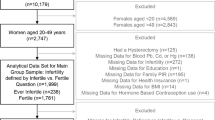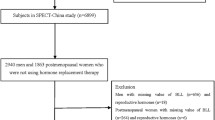Abstract
Heavy metals such as lead, mercury, and cadmium have been identified to have negative impacts on human health. Although the individual effects of these metals have been extensively researched, the present study aims to explore their combined effects and their association with serum sex hormones among adults. Data for this study were obtained from the general adult population of the 2013-2016 National Health and Nutrition Survey (NHANES) and included five metal (mercury, cadmium, manganese, lead, and selenium) exposures and three sex hormones (total testosterone [TT], estradiol [E2], and sex hormone-binding globulin [SHBG]) levels. The free androgen index (FAI) and TT/E2 ratio were also calculated. The relationships between blood metals and serum sex hormones were analysed using linear regression and restricted cubic spline regression. The effect of blood metal mixtures on sex hormone levels was examined using the quantile g-computation (qgcomp) model. There were 3,499 participants in this study, including 1,940 males and 1,559 females. In males, positive relationships between blood cadmium and serum SHBG (β=0.049 [0.006, 0.093]), lead and SHBG (β=0.040 [0.002, 0.079]), manganese and FAI (β=0.080 [0.016, 0.144]), and selenium and FAI (β=0.278 [0.054, 0.502]) were observed. In contrast, manganese and SHBG (β=-0.137 [-0.237, -0.037]), selenium and SHBG (β=-0.281 [-0.533, -0.028]), and manganese and TT/E2 ratio (β=-0.094 [-0.158, -0.029]) were negative associations. In females, blood cadmium and serum TT (β=0.082 [0.023, 0.141]), manganese and E2 (β=0.282 [0.072, 0.493]), cadmium and SHBG (β=0.146 [0.089, 0.203]), lead and SHBG (β=0.163 [0.095, 0.231]), and lead and TT/E2 ratio (β=0.174 [0.056, 0.292]) were positive relationships, while lead and E2 (β=-0.168 [-0.315, -0.021]) and FAI (β=-0.157 [-0.228, -0.086]) were negative associations. This correlation was stronger among elderly women (>50 years old). The qgcomp analysis revealed that the positive effect of mixed metals on SHBG was mainly driven by cadmium, while the negative effect of mixed metals on FAI was mainly driven by lead. Our findings indicate that exposure to heavy metals may disrupt hormonal homeostasis in adults, particularly in older women.

Similar content being viewed by others
Data availability
Publicly available datasets were analyzed in this study. This data can be found here: https://www.cdc.gov/nchs/nhanes/.
References
Agusa T, Kunito T, Iwata H, Monirith I, Chamnan C, Tana TS, Subramanian A, Tanabe S (2007) Mercury in hair and blood from residents of Phnom Penh (Cambodia) and possible effect on serum hormone levels. Chemosphere 68:590–596
Ali I, Engstrom A, Vahter M, Skerfving S, Lundh T, Lidfeldt J, Samsioe G, Halldin K, Akesson A (2014) Associations between cadmium exposure and circulating levels of sex hormones in postmenopausal women. Environ Res 134:265–269
Allen NE, Appleby PN, Davey GK, Key TJ (2002) Lifestyle and nutritional determinants of bioavailable androgens and related hormones in British men. Cancer Causes Control 13:353–363
Banos G, Guarner V, Perez-Torres I (2011) Sex steroid hormones, cardiovascular diseases and the metabolic syndrome. Cardiovasc Hematol Agents Med Chem 9:137–146
Bond A, Davis C (1987) Sex hormone binding globulin in clinical perspective. Acta Obstet Gynecol Scand 66:255–262
Cigarran S, Pousa M, Castro MJ, Gonzalez B, Martinez A, Barril G, Aguilera A, Coronel F, Stenvinkel P, Carrero JJ (2013) Endogenous testosterone, muscle strength, and fat-free mass in men with chronic kidney disease. J Ren Nutr 23:e89–e95
Cinar V, Polat Y, Baltaci AK, Mogulkoc R (2011) Effects of magnesium supplementation on testosterone levels of athletes and sedentary subjects at rest and after exhaustion. Biol Trace Elem Res 140:18–23
Clemens S, Ma JF (2016) Toxic Heavy Metal and Metalloid Accumulation in Crop Plants and Foods. Annu Rev Plant Biol 67:489–512
Cunningham GR (2015) Testosterone and metabolic syndrome. Asian J Androl 17:192–196
Dearth RK, Hiney JK, Srivastava V, Burdick SB, Bratton GR, Dees WL (2002) Effects of lead (Pb) exposure during gestation and lactation on female pubertal development in the rat. Reprod Toxicol 16:343–352
Duan W, Xu C, Liu Q, Xu J, Weng Z, Zhang X, Basnet TB, Dahal M, Gu A (2020) Levels of a mixture of heavy metals in blood and urine and all-cause, cardiovascular disease and cancer mortality: A population-based cohort study. Environ Pollut 263:114630
Finkelstein JS, Lee H, Burnett-Bowie SA, Pallais JC, Yu EW, Borges LF, Jones BF, Barry CV, Wulczyn KE, Thomas BJ, Leder BZ (2013) Gonadal steroids and body composition, strength, and sexual function in men. N Engl J Med 369:1011–1022
Flores-Ramirez I, Baranda-Avila N, Langley E (2019) Breast Cancer Stem Cells and Sex Steroid Hormones. Curr Stem Cell Res Ther 14:398–404
Gianatti EJ, Grossmann M (2020) Testosterone deficiency in men with Type 2 diabetes: pathophysiology and treatment. Diabet Med 37:174–186
Goldman AL, Bhasin S, Wu FCW, Krishna M, Matsumoto AM, Jasuja R (2017) A Reappraisal of Testosterone's Binding in Circulation: Physiological and Clinical Implications. Endocr Rev 38:302–324
Heck AL, Handa RJ (2019) Sex differences in the hypothalamic-pituitary-adrenal axis' response to stress: an important role for gonadal hormones. Neuropsychopharmacology 44:45–58
Hu P, Su W, Vinturache A, Gu H, Cai C, Lu M, Ding G (2021) Urinary 3-phenoxybenzoic acid (3-PBA) concentration and pulmonary function in children: A National Health and Nutrition Examination Survey (NHANES) 2007-2012 analysis. Environ Pollut 270:116178
Iavicoli I, Fontana L, Bergamaschi A (2009) The effects of metals as endocrine disruptors. J Toxicol Environ Health B Crit Rev 12:206–223
Kelly DM, Jones TH (2013) Testosterone: a metabolic hormone in health and disease. J Endocrinol 217:R25–R45
Kresovich JK, Argos M, Turyk ME (2015) Associations of lead and cadmium with sex hormones in adult males. Environ Res 142:25–33
Kumar A, Banerjee A, Singh D, Thakur G, Kasarpalkar N, Gavali S, Gadkar S, Madan T, Mahale SD, Balasinor NH, Sachdeva G (2018) Estradiol: A Steroid with Multiple Facets. Horm Metab Res 50:359–374
Lewis RC, Meeker JD (2015) Biomarkers of exposure to molybdenum and other metals in relation to testosterone among men from the United States National Health and Nutrition Examination Survey 2011-2012. Fertil Steril 103:172–178
Maggio M, Ceda GP, Lauretani F, Cattabiani C, Avantaggiato E, Morganti S, Ablondi F, Bandinelli S, Dominguez LJ, Barbagallo M, Paolisso G, Semba RD, Ferrucci L (2011) Magnesium and anabolic hormones in older men. Int J Androl 34:e594–e600
Morgentaler A, Traish A, Hackett G, Jones TH, Ramasamy R (2019) Diagnosis and Treatment of Testosterone Deficiency: Updated Recommendations From the Lisbon 2018 International Consultation for Sexual Medicine. Sex Med Rev 7:636–649
Nagata C, Konishi K, Goto Y, Tamura T, Wada K, Hayashi M, Takeda N, Yasuda K (2016) Associations of urinary cadmium with circulating sex hormone levels in pre- and postmenopausal Japanese women. Environ Res 150:82–87
Nasiadek M, Danilewicz M, Sitarek K, Swiatkowska E, Darago A, Stragierowicz J, Kilanowicz A (2018) The effect of repeated cadmium oral exposure on the level of sex hormones, estrous cyclicity, and endometrium morphometry in female rats. Environ Sci Pollut Res Int 25:28025–28038
Pillerova M, Borbelyova V, Hodosy J, Riljak V, Renczes E, Frick KM, Tothova L (2021) On the role of sex steroids in biological functions by classical and non-classical pathways. An update. Front Neuroendocrinol 62:100926
Qiu Z, Chen X, Geng T, Wan Z, Lu Q, Li L, Zhu K, Zhang X, Liu Y, Lin X, Chen L, Shan Z, Liu L, Pan A, Liu G (2022) Associations of Serum Carotenoids With Risk of Cardiovascular Mortality Among Individuals With Type 2 Diabetes: Results From NHANES. Diabetes Care 45:1453–1461
Rami Y, Ebrahimpour K, Maghami M, Shoshtari-Yeganeh B, Kelishadi R (2022) The Association Between Heavy Metals Exposure and Sex Hormones: a Systematic Review on Current Evidence. Biol Trace Elem Res 200:3491–3510
Rehman K, Fatima F, Waheed I, Akash MSH (2018) Prevalence of exposure of heavy metals and their impact on health consequences. J Cell Biochem 119:157–184
Riggs BL (2000) The mechanisms of estrogen regulation of bone resorption. J Clin Invest 106:1203–1204
Rotter I, Kosik-Bogacka DI, Dolegowska B, Safranow K, Kuczynska M, Laszczynska M (2016) Analysis of the relationship between the blood concentration of several metals, macro- and micronutrients and endocrine disorders associated with male aging. Environ Geochem Health 38:749–761
Russell N, Grossmann M (2019) MECHANISMS IN ENDOCRINOLOGY: Estradiol as a male hormone. Eur J Endocrinol 181:R23–R43
Schmidt S (2020) Quantile g-Computation: A New Method for Analyzing Mixtures of Environmental Exposures. Environ Health Perspect 128:104004
Scinicariello F, Buser MC (2016) Serum Testosterone Concentrations and Urinary Bisphenol A, Benzophenone-3, Triclosan, and Paraben Levels in Male and Female Children and Adolescents: NHANES 2011-2012. Environ Health Perspect 124:1898–1904
Selby C (1990) Sex hormone binding globulin: origin, function and clinical significance. Ann Clin Biochem 27(Pt 6):532–541
Simo R, Saez-Lopez C, Barbosa-Desongles A, Hernandez C, Selva DM (2015) Novel insights in SHBG regulation and clinical implications. Trends Endocrinol Metab 26:376–383
Singh R, Gautam N, Mishra A, Gupta R (2011) Heavy metals and living systems: An overview. Indian J Pharm 43:246–253
Srivastava V, Dearth RK, Hiney JK, Ramirez LM, Bratton GR, Dees WL (2004) The effects of low-level Pb on steroidogenic acute regulatory protein (StAR) in the prepubertal rat ovary. Toxicol Sci 77:35–40
Takiguchi M, Yoshihara S (2006) New aspects of cadmium as endocrine disruptor. Environ Sci 13:107–116
Tao C, Li Z, Fan Y, Li X, Qian H, Yu H, Xu Q, Lu C (2021) Independent and combined associations of urinary heavy metals exposure and serum sex hormones among adults in NHANES 2013-2016. Environ Pollut 281:117097
Telisman S, Colak B, Pizent A, Jurasovic J, Cvitkovic P (2007) Reproductive toxicity of low-level lead exposure in men. Environ Res 105:256–266
Wang Y, Aimuzi R, Nian M, Zhang Y, Luo K, Zhang J (2021) Perfluoroalkyl substances and sex hormones in postmenopausal women: NHANES 2013-2016. Environ Int 149:106408
Wei B, O'Connor R, Goniewicz M, Hyland A (2020) Association between Urinary Metabolite Levels of Organophosphorus Flame Retardants and Serum Sex Hormone Levels Measured in a Reference Sample of the US General Population. Expo Health 12:905–916
Acknowledgments
We appreciate the people who contributed to the NHANES data we studied.
Funding
No specific funding was received for this work.
Author information
Authors and Affiliations
Contributions
Qiongshan Liu: Conceptualization, Methodology, Software, Formal analysis, Writing-original draft, Visualization. Shijian Hu: Conceptualization, Methodology, Writing-original draft. Fufang Fan: Writing-review and editing. Zhixiang Zhen: Project administration, Supervision. Xinye Zhou: Conceptualization, Methodology, Supervision. Yuanfeng Zhang: Conceptualization, Methodology, Project administration, Writing-review and editing, Supervision.
Corresponding author
Ethics declarations
Ethics approval and consent to participant
All participants provided written informed consent and study procedures were approved by the National Center for Health Statistics Research Ethics Review Board.
Consent to publish
The manuscript is approved by all authors for publication.
Competing interests
The authors declare no or competing interests.
Additional information
Responsible Editor: Lotfi Aleya
Publisher’s note
Springer Nature remains neutral with regard to jurisdictional claims in published maps and institutional affiliations.
Supplementary Information
Below is the link to the electronic supplementary material.
Rights and permissions
Springer Nature or its licensor (e.g. a society or other partner) holds exclusive rights to this article under a publishing agreement with the author(s) or other rightsholder(s); author self-archiving of the accepted manuscript version of this article is solely governed by the terms of such publishing agreement and applicable law.
About this article
Cite this article
Liu, Q., Hu, S., Fan, F. et al. Association of blood metals with serum sex hormones in adults: A cross-sectional study. Environ Sci Pollut Res 30, 69628–69638 (2023). https://doi.org/10.1007/s11356-023-27384-5
Received:
Accepted:
Published:
Issue Date:
DOI: https://doi.org/10.1007/s11356-023-27384-5




